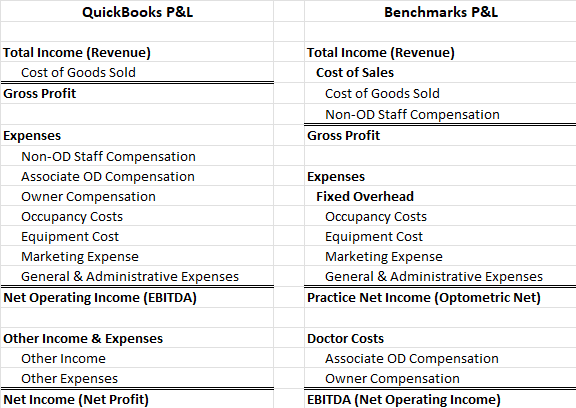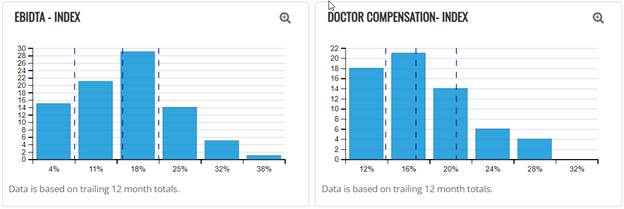Last week, we talked about different ways to measure profit using metrics found on a practice’s income statement or P&L. This week, we’ll take a second look at Net Operating Income, which on our chart of accounts is also a calculation of EBITDA, discuss what EBITDA means, and then cover why we use a metric called Practice Net Income or Optometric Net to benchmark profitability.
Net Operating Income
As we shared last week, Books & Benchmarks intentionally uses different financial layouts for the QuickBooks files we keep for our clients and the Financial Benchmark Report we generate in our member portal. Side-by-side, here’s how they are different:

Picking up where we left off, the Net Operating Income (also called Ordinary Income) in the QuickBooks statement is the bottom line of our financial benchmarks. We focus on this because unrelated or unusual revenue and expenses (Other Income & Expenses on the P&L) aren’t pertinent to understanding the business’s performance. Our Net Operating Income is also a measure of EBITDA, so let’s start there as we discuss how Books & Benchmarks looks at profitability.
EBITDA
EBITDA stands for Earnings Before Interest, Tax, Depreciation, and Amortization. It’s the income a practice would generate if it didn’t have any debt or deductions related to capital expenditures. Its most common use is in business valuation because in an asset sale (as opposed to a stock sale), a seller is responsible for repaying any outstanding debt. EBITDA, therefore, is the income a buyer can expect to receive.
EBITDA is a useful metric—and a common talking point with all the private equity acquisitions these past five years—which is why we structure our Net Operating Income line to be EBITDA. But it isn’t perfect.
Many owners will set their salary significantly higher or lower than what it would cost to replace their patient care time and management time. As a result, benchmarking EBITDA as a percent of revenue doesn’t mean much without normalizing adjustments to the owner’s salary.
Consider the following histograms of EBITDA and doctor pay for our Books & Benchmarks practices (x-axis labels are the midpoints of a range, y-axis is the number of practices that fall in the range):

Notice that the range for EBITDA and doctor compensation is from about 0%-30%. In practices where doctor pay is over 20%, that means an owner is taking an above-market wage and EBITDA is corresponding lower. Where doctor pay is lower, that often means that owners are taking a low (or in some cases no) salary. And EBITDA will be higher in those cases.
And that’s setting aside elective expenses that legitimately belong on the books but wouldn’t apply to a future owner of the practice. I talked to a practice recently that buys season tickets to a local sports arena to share as a staff benefit. Many of our practices spend tens of thousands of dollars bringing their staff to industry events, like the upcoming IDOC Connection. Some pay rent for buildings they own that differs from what they would charge a tenant that’s, um, not them.
A raw EBITDA is a useful, but not perfect way to benchmark practice performance. Adjustments to owner compensation and elective expenses are always made when valuing a business. Given that adjustments to owner wages can often be well over $100,000, we rely instead on a metric that controls for owner wages.
Practice Net Income
The best way we know to benchmark profit is a metric that makes apples-to-apples comparisons between single-doctor practices and multi-doctor practices, all-partner practices and practices with a mix of owners and associates, and practices where owners pay themselves a lot or a little.
To do this, we combine the pay for all the ODs in the practice with EBITDA to answer the hypothetical of: if all practices only had owners, how much of the revenue would go to those owners, regardless of their mix of salary and profit?
And that’s Practice Net. It’s a useful way of comparing the salary and profits available to doctors in an optometry practice. The best way. Here’s what Practice Net looks like:

It still has a wide distribution (new, small practices at the low end and large, high-profit rural practices at the high end), but most practices cluster between 25% of revenues and 35%.
In the spirit of knowing the limits of any metric, Practice Net can be deceiving if a practice is inefficient with its associates. I worked with a $1.1MM revenue practice with a 33% Practice Net which didn’t yield any meaningful income to the owner because it took two full-time associate ODs to generate what should have been one full-time OD’s revenue number. And if there’s debt in the business, any of these profit figures will not tell an owner how much income they can take out of the practice.
To wrap up, different measures of profit each have their uses. Net Income on the P&L should generally be understood as the number driving an owner’s tax liability. Net Operating Income or EBITDA, especially adjusted EBITDA, is the essential number when valuing a business in an asset sale. If you want to assess how your profitability compares to your peers, Practice Net is your number.
If you want to learn more about our approach to helping independent owners understand their businesses and make better decisions, schedule a call with our experts today!






